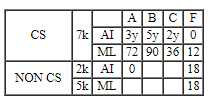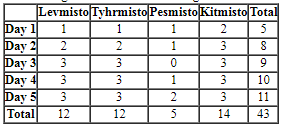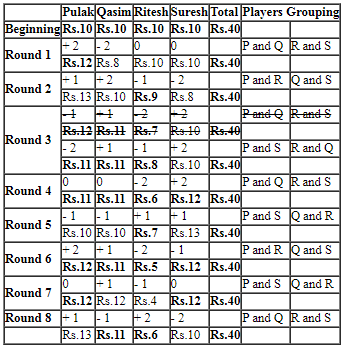CAT 2022 DILR - Slot 3 Past Year Questions
CAT 2022 | DILR Set 1
All the first-year students in the computer science (CS) department in a university take both the courses (i) AI and (ii) ML. Students from other departments (non-CS students) can also take one of these two courses, but not both. Students who fail in a course get an F grade; others pass and are awarded A or B or C grades depending on their performance. The following are some additional facts about the number of students who took these two courses this year and the grades they obtained.
- The numbers of non-CS students who took AI and ML were in the ratio 2 : 5.
- The number of non-CS students who took either AI or ML was equal to the number of CS students.
- The numbers of non-CS students who failed in the two courses were the same and their total is equal to the number of CS students who got a C grade in ML.
- In both the courses, 50% of the students who passed got a B grade. But, while the numbers of students who got A and C grades were the same for AI, they were in the ratio 3 : 2 for ML.
- No CS student failed in AI, while no non-CS student got an A grade in AI.
- The numbers of CS students who got A, B and C grades respectively in AI were in the ratio 3 : 5 : 2, while in ML the ratio was 4 : 5 : 2.
- The ratio of the total number of non-CS students failing in one of the two courses to the number of CS students failing in one of the two courses was 3 : 1.
- 30 students failed in ML.
1. How many students took AI?
- 210
- 90
- 60
- 270
From directions 1, 2, 3, 5, 6; we can fill the table as below.
 From 7th direction, Total number of non CS students failing in one of the two courses : CS student failing in one of the two courses = 3:1
2x:z = 3:1
Z = 2x/3
From 8th direction, z + x =30
5x/3 = 80
X = 18
So, we can fill values in the table:
From 7th direction, Total number of non CS students failing in one of the two courses : CS student failing in one of the two courses = 3:1
2x:z = 3:1
Z = 2x/3
From 8th direction, z + x =30
5x/3 = 80
X = 18
So, we can fill values in the table:
 Also, every student take both the courses in CS. So, number of students in AI = number of students in ML = 210
So, total number of students in CS = 210
K = 30
So, in Non CS, AI students = 60, in Non CS, ML students = 150
Also, 3y + 5y + 2y =210 implies y = 21.
So, we can put values for the first row.
Also, every student take both the courses in CS. So, number of students in AI = number of students in ML = 210
So, total number of students in CS = 210
K = 30
So, in Non CS, AI students = 60, in Non CS, ML students = 150
Also, 3y + 5y + 2y =210 implies y = 21.
So, we can put values for the first row.
 By taking 4th direction, we can have the final table as below:
By taking 4th direction, we can have the final table as below:
 210 + 60 = 270 ans.
210 + 60 = 270 ans.
2. How many CS students failed in ML? (in numerical value)
From directions 1, 2, 3, 5, 6; we can fill the table as below.
 From 7th direction, Total number of non CS students failing in one of the two courses : CS student failing in one of the two courses = 3:1
2x:z = 3:1
Z = 2x/3
From 8th direction, z + x =30
5x/3 = 80
X = 18
So, we can fill values in the table:
From 7th direction, Total number of non CS students failing in one of the two courses : CS student failing in one of the two courses = 3:1
2x:z = 3:1
Z = 2x/3
From 8th direction, z + x =30
5x/3 = 80
X = 18
So, we can fill values in the table:
 Also, every student take both the courses in CS. So, number of students in AI = number of students in ML = 210
So, total number of students in CS = 210
K = 30
So, in Non CS, AI students = 60, in Non CS, ML students = 150
Also, 3y + 5y + 2y =210 implies y = 21.
So, we can put values for the first row.
Also, every student take both the courses in CS. So, number of students in AI = number of students in ML = 210
So, total number of students in CS = 210
K = 30
So, in Non CS, AI students = 60, in Non CS, ML students = 150
Also, 3y + 5y + 2y =210 implies y = 21.
So, we can put values for the first row.
 By taking 4th direction, we can have the final table as below:
By taking 4th direction, we can have the final table as below:
 12 students failed in ML.
12 students failed in ML.
3. How many non-CS students got A grade in ML? (in numerical value)
From directions 1, 2, 3, 5, 6; we can fill the table as below.
 From 7th direction, Total number of non CS students failing in one of the two courses : CS student failing in one of the two courses = 3:1
2x:z = 3:1
Z = 2x/3
From 8th direction, z + x =30
5x/3 = 80
X = 18
So, we can fill values in the table:
From 7th direction, Total number of non CS students failing in one of the two courses : CS student failing in one of the two courses = 3:1
2x:z = 3:1
Z = 2x/3
From 8th direction, z + x =30
5x/3 = 80
X = 18
So, we can fill values in the table:
 Also, every student take both the courses in CS. So, number of students in AI = number of students in ML = 210
So, total number of students in CS = 210
K = 30
So, in Non CS, AI students = 60, in Non CS, ML students = 150
Also, 3y + 5y + 2y =210 implies y = 21.
So, we can put values for the first row.
Also, every student take both the courses in CS. So, number of students in AI = number of students in ML = 210
So, total number of students in CS = 210
K = 30
So, in Non CS, AI students = 60, in Non CS, ML students = 150
Also, 3y + 5y + 2y =210 implies y = 21.
So, we can put values for the first row.
 By taking 4th direction, we can have the final table as below:
By taking 4th direction, we can have the final table as below:
 27 non CS students got A grade in ML.
27 non CS students got A grade in ML.
4. How many students got A grade in AI?
- 84
- 42
- 63
- 99
From directions 1, 2, 3, 5, 6; we can fill the table as below.
 From 7th direction, Total number of non CS students failing in one of the two courses : CS student failing in one of the two courses = 3:1
2x:z = 3:1
Z = 2x/3
From 8th direction, z + x =30
5x/3 = 80
X = 18
So, we can fill values in the table:
From 7th direction, Total number of non CS students failing in one of the two courses : CS student failing in one of the two courses = 3:1
2x:z = 3:1
Z = 2x/3
From 8th direction, z + x =30
5x/3 = 80
X = 18
So, we can fill values in the table:
 Also, every student take both the courses in CS. So, number of students in AI = number of students in ML = 210
So, total number of students in CS = 210
K = 30
So, in Non CS, AI students = 60, in Non CS, ML students = 150
Also, 3y + 5y + 2y =210 implies y = 21.
So, we can put values for the first row.
Also, every student take both the courses in CS. So, number of students in AI = number of students in ML = 210
So, total number of students in CS = 210
K = 30
So, in Non CS, AI students = 60, in Non CS, ML students = 150
Also, 3y + 5y + 2y =210 implies y = 21.
So, we can put values for the first row.
 By taking 4th direction, we can have the final table as below:
By taking 4th direction, we can have the final table as below:
 63.
63.
5. How many non-CS students got B grade in ML?
- 165
- 25
- 90
- 75
From directions 1, 2, 3, 5, 6; we can fill the table as below.
 From 7th direction, Total number of non CS students failing in one of the two courses : CS student failing in one of the two courses = 3:1
2x:z = 3:1
Z = 2x/3
From 8th direction, z + x =30
5x/3 = 80
X = 18
So, we can fill values in the table:
From 7th direction, Total number of non CS students failing in one of the two courses : CS student failing in one of the two courses = 3:1
2x:z = 3:1
Z = 2x/3
From 8th direction, z + x =30
5x/3 = 80
X = 18
So, we can fill values in the table:
 Also, every student take both the courses in CS. So, number of students in AI = number of students in ML = 210
So, total number of students in CS = 210
K = 30
So, in Non CS, AI students = 60, in Non CS, ML students = 150
Also, 3y + 5y + 2y =210 implies y = 21.
So, we can put values for the first row.
Also, every student take both the courses in CS. So, number of students in AI = number of students in ML = 210
So, total number of students in CS = 210
K = 30
So, in Non CS, AI students = 60, in Non CS, ML students = 150
Also, 3y + 5y + 2y =210 implies y = 21.
So, we can put values for the first row.
 By taking 4th direction, we can have the final table as below:
By taking 4th direction, we can have the final table as below:
 75
75
Correct Answer 1
Option D
Correct Answer 2
12
Correct Answer 3
27
Correct Answer 4
Option C
Correct Answer 5
Option D
CAT 2022 | DILR Set 2
In the following, a year corresponds to 1st of January of that year.
A study to determine the mortality rate for a disease began in 1980. The study chose 1000 males and 1000 females and followed them for forty years or until they died, whichever came first. The 1000 males chosen in 1980 consisted of 250 each of ages 10 to less than 20, 20 to less than 30, 30 to less than 40, and 40 to less than 50. The 1000 females chosen in 1980 also consisted of 250 each of ages 10 to less than 20, 20 to less than 30, 30 to less than 40, and 40 to less than 50.
The four figures below depict the age profile of those among the 2000 individuals who were still alive in 1990, 2000, 2010, and 2020. The blue bars in each figure represent the number of males in each age group at that point in time, while the pink bars represent the number of females in each age group at that point in time. The numbers next to the bars give the exact numbers being represented by the bars. For example, we know that 230 males among those tracked and who were alive in 1990 were aged between 20 and 30.
6. In 2000, what was the ratio of the number of dead males to dead females among those being tracked?
- 41 : 43
- 71 : 69
- 129 : 131
- 109 : 107
We know that in 1980, total number of males = total number of females = 1000. Also, 1000 = Deaths + alive people So, number of deaths of males = 1000 - ( 180+205+160+100) = 355 Number of deaths of females = 1000 – (210 + 175+ 150 + 120) = 345 So, required ratio = 355:345 = 71:69 So, required ratio = 355:345 = 71:69
7. How many people who were being tracked and who were between 30 and 40 years of age in 1980 survived until 2010?
- 190
- 110
- 310
- 90
If a person falls in the age group (30-40), he/she should fall in (60-70) age group in 2010. So, in third graph, (90+100) = 190 would be the answer.
8. How many individuals who were being tracked and who were less than 30 years of age in 1980 survived until 2020?
- 230
- 580
- 470
- 240
Less than 30 years means, we need to take 10-20, 20-30 categories. In 2020, these people would fall in 50-60, 60-70 age group categories. So, answer = 140 + 125 + 50 + 100 + 105 + 60 = 470. Hence 3rd option.
9. How many of the males who were being tracked and who were between 20 and 30 years of age in 1980 died in the period 2000 to 2010? (in numerical value)
In 2000, these people will fall in 40-50. In 2010, these people will fall in 50-60. In 2000, 205 male survivors were there. In 2010, 165 male survivors were there. That means 205-165 = 40 died in the given period.
10. How many of the females who were being tracked and who were between 20 and 30 years of age in 1980 died between the ages of 50 and 60? (in numerical value)
In 1980, age (20-30) => In 1990, age (30-40) => In 2000, age (40-50) => In 2010, age (50 -60) From given bar graph, in 2000, 175 females were alive in the age group 40-50 But in 2010, 145 females were alive in the age group 50-60 Hence, females died in the age (50-60) = 175 - 145 = 30
Correct Answer 6
Option B
Correct Answer 7
Option A
Correct Answer 8
Option C
Correct Answer 9
40
Correct Answer 10
30
CAT 2022 | DILR Set 3
There are only four neighbourhoods in a city – Levmisto, Tyhrmisto, Pesmisto and Kitmisto. During the onset of a pandemic, the number of new cases of a disease in each of these neighbourhoods was recorded over a period of five days. On each day, the number of new cases recorded in any of the neighbourhoods was either 0, 1, 2 or 3.
The following facts are also known:
- There was at least one new case in every neighbourhood on Day 1.
- On each of the five days, there were more new cases in Kitmisto than in Pesmisto.
- The number of new cases in the city in a day kept increasing during the five-day period. The number of new cases on Day 3 was exactly one more than that on Day 2.
- The maximum number of new cases in a day in Pesmisto was 2, and this happened only once during the five-day period.
- Kitmisto is the only place to have 3 new cases on Day 2.
- The total numbers of new cases in Levmisto, Tyhrmisto, Pesmisto and Kitmisto over the five-day period were 12, 12, 5 and 14 respectively.
11. What BEST can be concluded about the total number of new cases in the city on Day 2?
- Exactly 7
- Either 6 or 7
- Either 7 or 8
- Exactly 8
Let the denotation for Levmisto = L, Tyhrmisto = T, Pesmisto = P and Kitmisto = K
The total number of new cases in the city over five-day period
= 12 + 12 + 5 + 14 = 43
Since the new cases in the city kept on increasing every day with Day 3 is exactly one more case than Day 2, the only possibility of new cases for-
Day 1 = 5, Day 2 = 8, Day 3 = 9, Day 4 = 10 and Day 5 = 11, Total = 43
Further, there is at least one new case on Day 1
Only possibility for Day 1,
L = 1 case, T = 1 case, P = 1 case and K = 2 cases, Total = 5 cases
Also, K is the only place to have 3 new cases on Day 2
And to have total of 12 cases in each L and T
Day 2 = 2 cases, Day 3 = 3 cases, Day 4 = 3 cases and Day 5 = 3 cases
The rest of given information can be gathered as follows-
 Now we are ready to answer the questions.
The total number of new cases in the city on Day 2 = exactly 8
Now we are ready to answer the questions.
The total number of new cases in the city on Day 2 = exactly 8
12. What BEST can be concluded about the number of new cases in Levmisto on Day 3?
- Exactly 2
- Exactly 3
- Either 0 or 1
- Either 2 or 3
Let the denotation for Levmisto = L, Tyhrmisto = T, Pesmisto = P and Kitmisto = K
The total number of new cases in the city over five-day period
= 12 + 12 + 5 + 14 = 43
Since the new cases in the city kept on increasing every day with Day 3 is exactly one more case than Day 2, the only possibility of new cases for-
Day 1 = 5, Day 2 = 8, Day 3 = 9, Day 4 = 10 and Day 5 = 11, Total = 43
Further, there is at least one new case on Day 1
Only possibility for Day 1,
L = 1 case, T = 1 case, P = 1 case and K = 2 cases, Total = 5 cases
Also, K is the only place to have 3 new cases on Day 2
And to have total of 12 cases in each L and T
Day 2 = 2 cases, Day 3 = 3 cases, Day 4 = 3 cases and Day 5 = 3 cases
The rest of given information can be gathered as follows-
 Now we are ready to answer the questions.
The number of new cases in Levmisto on Day 3 = exactly 3
Now we are ready to answer the questions.
The number of new cases in Levmisto on Day 3 = exactly 3
13. On which day(s) did Pesmisto not have any new case?
- Only Day 3
- Both Day 2 and Day 3
- Only Day 2
- Both Day 2 and Day 4
Let the denotation for Levmisto = L, Tyhrmisto = T, Pesmisto = P and Kitmisto = K
The total number of new cases in the city over five-day period
= 12 + 12 + 5 + 14 = 43
Since the new cases in the city kept on increasing every day with Day 3 is exactly one more case than Day 2, the only possibility of new cases for-
Day 1 = 5, Day 2 = 8, Day 3 = 9, Day 4 = 10 and Day 5 = 11, Total = 43
Further, there is at least one new case on Day 1
Only possibility for Day 1,
L = 1 case, T = 1 case, P = 1 case and K = 2 cases, Total = 5 cases
Also, K is the only place to have 3 new cases on Day 2
And to have total of 12 cases in each L and T
Day 2 = 2 cases, Day 3 = 3 cases, Day 4 = 3 cases and Day 5 = 3 cases
The rest of given information can be gathered as follows-
 Now we are ready to answer the questions.
Only on Day 3, Pesmisto did not have any new case
Now we are ready to answer the questions.
Only on Day 3, Pesmisto did not have any new case
14. Which of the two statements below is/are necessarily false? Statement A: There were 2 new cases in Tyhrmisto on Day 3. Statement B: There were no new cases in Pesmisto on Day 2.
- Statement B only
- Both Statement A and Statement B
- Neither Statement A nor Statement B
- Statement A only
Let the denotation for Levmisto = L, Tyhrmisto = T, Pesmisto = P and Kitmisto = K
The total number of new cases in the city over five-day period
= 12 + 12 + 5 + 14 = 43
Since the new cases in the city kept on increasing every day with Day 3 is exactly one more case than Day 2, the only possibility of new cases for-
Day 1 = 5, Day 2 = 8, Day 3 = 9, Day 4 = 10 and Day 5 = 11, Total = 43
Further, there is at least one new case on Day 1
Only possibility for Day 1,
L = 1 case, T = 1 case, P = 1 case and K = 2 cases, Total = 5 cases
Also, K is the only place to have 3 new cases on Day 2
And to have total of 12 cases in each L and T
Day 2 = 2 cases, Day 3 = 3 cases, Day 4 = 3 cases and Day 5 = 3 cases
The rest of given information can be gathered as follows-
 Now we are ready to answer the questions.
Statement A: There were 2 new cases in Tyhrmisto on Day 3
False
Statement B: There were no new cases in Pesmisto on Day 2
False
Hence, both Statement a and Statement b are false
Now we are ready to answer the questions.
Statement A: There were 2 new cases in Tyhrmisto on Day 3
False
Statement B: There were no new cases in Pesmisto on Day 2
False
Hence, both Statement a and Statement b are false
15. On how many days did Levmisto and Tyhrmisto have the same number of new cases?
- 2
- 5
- 3
- 4
Let the denotation for Levmisto = L, Tyhrmisto = T, Pesmisto = P and Kitmisto = K
The total number of new cases in the city over five-day period
= 12 + 12 + 5 + 14 = 43
Since the new cases in the city kept on increasing every day with Day 3 is exactly one more case than Day 2, the only possibility of new cases for-
Day 1 = 5, Day 2 = 8, Day 3 = 9, Day 4 = 10 and Day 5 = 11, Total = 43
Further, there is at least one new case on Day 1
Only possibility for Day 1,
L = 1 case, T = 1 case, P = 1 case and K = 2 cases, Total = 5 cases
Also, K is the only place to have 3 new cases on Day 2
And to have total of 12 cases in each L and T
Day 2 = 2 cases, Day 3 = 3 cases, Day 4 = 3 cases and Day 5 = 3 cases
The rest of given information can be gathered as follows-
 Now we are ready to answer the questions.
On all 5 days Levmisto and Tyhrmisto have the same number of new cases
Now we are ready to answer the questions.
On all 5 days Levmisto and Tyhrmisto have the same number of new cases
Correct Answer 11
Option D
Correct Answer 12
Option B
Correct Answer 13
Option A
Correct Answer 14
Option B
Correct Answer 15
Option B
CAT 2022 | DILR Set 4
Pulak, Qasim, Ritesh, and Suresh participated in a tournament comprising of eight rounds. In each round, they formed two pairs, with each of them being in exactly one pair. The only restriction in the pairing was that the pairs would change in successive rounds. For example, if Pulak formed a pair with Qasim in the first round, then he would have to form a pair with Ritesh or Suresh in the second round. He would be free to pair with Qasim again in the third round. In each round, each pair decided whether to play the game in that round or not. If they decided not to play, then no money was exchanged between them. If they decided to play, they had to bet either Rs.1 or Rs.2 in that round. For example, if they chose to bet Rs.2, then the player winning the game got Rs.2 from the one losing the game.
At the beginning of the tournament, the players had Rs.10 each. The following table shows partial information about the amounts that the players had at the end of each of the eight rounds. It shows every time a player had Rs.10 at the end of a round, as well as every time, at the end of a round, a player had either the minimum or the maximum amount that he would have had across the eight rounds. For example, Suresh had Rs.10 at the end of Rounds 1, 3, and 8 and not after any of the other rounds. The maximum amount that he had at the end of any round was Rs.13 (at the end of Round 5), and the minimum amount he had at the end of any round was Rs.8 (at the end of Round 2). At the end of all other rounds, he must have had either Rs.9, Rs.11, or Rs.12.
It was also known that Pulak and Qasim had the same amount of money with them at the end of Round 4.

16. What BEST can be said about the amount of money that Ritesh had with him at the end of Round 8?
- Rs. 5 or Rs. 6
- Rs. 4 or Rs. 5
- Exactly Rs. 6
- Exactly Rs. 5
Since the total amount among them = Rs.40
Some of the values can be distributed as follows.
 Now we can answer the questions.
Rs.4 is the minimum amount Ritesh has in any round, so he must have won in Round 8 and gained Rs.2. hence, the amount of money that Ritesh had with him at the end of Round 8 = 4 + 2 = Rs.6
Now we can answer the questions.
Rs.4 is the minimum amount Ritesh has in any round, so he must have won in Round 8 and gained Rs.2. hence, the amount of money that Ritesh had with him at the end of Round 8 = 4 + 2 = Rs.6
17. What BEST can be said about the amount of money that Pulak had with him at the end of Round 6?
- Rs. 11 or Rs. 12
- Rs. 12 or Rs. 13
- Exactly Rs. 11
- Exactly Rs. 12
Since the total amount among them = Rs.40
Some of the values can be distributed as follows.
 Now we can answer the questions.
The money Suresh had in Round 5 = Rs.13 (maximum) and in Round 7 = Rs.12
The only possible way to reach such value is by losing Rs.1 in Round 6 and gaining 0 in Round 7
Also, the money Ritesh had in Round 5 = Rs.7 and in Round 7 = Rs.4
The only possible way to reach such value is by losing Rs.2 in Round 6 and losing Rs.1 in Round 7
Considering that, the amount of money that Pulak had with him at the end of Round 6 = Rs.10 + 2 = Rs.12
Now we can answer the questions.
The money Suresh had in Round 5 = Rs.13 (maximum) and in Round 7 = Rs.12
The only possible way to reach such value is by losing Rs.1 in Round 6 and gaining 0 in Round 7
Also, the money Ritesh had in Round 5 = Rs.7 and in Round 7 = Rs.4
The only possible way to reach such value is by losing Rs.2 in Round 6 and losing Rs.1 in Round 7
Considering that, the amount of money that Pulak had with him at the end of Round 6 = Rs.10 + 2 = Rs.12
18. How much money (in Rs.) did Ritesh have at the end of Round 4? (in numerical value)
Since the total amount among them = Rs.40
Some of the values can be distributed as follows.
 Now we can answer the questions.
The money (in Rs.) Ritesh had at the end of Round 4 = Rs.6
Now we can answer the questions.
The money (in Rs.) Ritesh had at the end of Round 4 = Rs.6
19. How many games were played with a bet of Rs. 2? (in numerical value)
Since the total amount among them = Rs.40
Some of the values can be distributed as follows.
 Now we can answer the questions.
6 games were played with a bet of Rs.2.
Now we can answer the questions.
6 games were played with a bet of Rs.2.
20. Which of the following pairings was made in Round 5? (in numerical value)
- Pulak and Suresh
- Qasim and Suresh
- Pulak and Qasim
- Pulak and Ritesh
Since the total amount among them = Rs.40
Some of the values can be distributed as follows.
 Now we can answer the questions.
Pulak and Suresh made a pair in round 5.
Now we can answer the questions.
Pulak and Suresh made a pair in round 5.
Correct Answer 16
Option C
Correct Answer 17
Option D
Correct Answer 18
6
Correct Answer 19
6
Correct Answer 20
Option A














